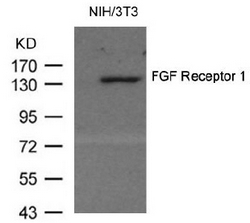FGFR1 Rabbit Polyclonal Antibody
Other products for "FGFR1"
Specifications
| Product Data | |
| Applications | WB |
| Recommended Dilution | Western Blot: 1/500-1/1000. Incubate membrane with diluted antibody in 5% nonfat milk, 1X TBSS, 0.1% Tween-20 at 4°C with gentle shaking, overnight. |
| Reactivities | Human, Mouse, Rat |
| Host | Rabbit |
| Clonality | Polyclonal |
| Immunogen | Peptide sequence around amino acids 152-156 (A-P-Y-W-T) derived from FGF Receptor 1 Human. |
| Specificity | This antibody detects endogenous levels of total FGF Receptor 1 (CD331/FGFR1) protein. |
| Formulation | PBS (without Mg2+ and Ca2+), pH 7.4, 150 mM NaCl State: Aff - Purified State: Liquid purified Ig fraction Stabilizer: 50% Glycerol Preservative: 0.02% Sodium Azide |
| Concentration | lot specific |
| Purification | Immunoaffinity Chromatography using epitope-specific peptide |
| Conjugation | Unconjugated |
| Storage | Store undiluted at 2-8°C for one month or (in aliquots) at -20°C for longer. Avoid repeated freezing and thawing. |
| Stability | Shelf life: one year from despatch. |
| Predicted Protein Size | 145 kDa |
| Gene Name | fibroblast growth factor receptor 1 |
| Database Link | |
| Background | FGFR1 (fibroblast growth factor receptor 1) is a member of the fibroblast growth factor receptor family and contains an Ig-like domain and a tyrosine kinase domain. This receptor has multiple isoforms and is a Type I membrane protein. FGFR1 is widely expressed, with distinct isoforms expressed in specific tissues. FGFR1 binds fibroblast growth factor and induces mitogenesis and cellular differentiation. Defects in FGFR1 result in Pfeiffer syndrome associated with craniosynostosis. FGFR1 can be modified by phosphorylation and can bind basic/acidic fibroblast factor depending on the receptor isoform. FGFR1 has been shown to interact with N-cadherin and NCAM. At the mRNA level, FGFR1 is highly expressed in developing human tissues including the brain (preferentially in neurons), vascular basement membranes, skin, and bone growth plates. It may be found in most anchorage dependent cells on their membrane and also may be localized around and in nuclei. Pfeiffer syndrome, as well as other disorders of human skeletal development, is the result of a mutation in the extracellular domain of FGFR1. |
| Synonyms | BFGFR, CEK, FGFBR, FLG, FLT2, HBGFR, BFGFR, bFGF-R-1, FLT-2, N-sam, Proto-oncogene c-Fgr |
| Reference Data | |
Documents
| Product Manuals |
| FAQs |
| SDS |
{0} Product Review(s)
0 Product Review(s)
Submit review
Be the first one to submit a review
Product Citations
*Delivery time may vary from web posted schedule. Occasional delays may occur due to unforeseen
complexities in the preparation of your product. International customers may expect an additional 1-2 weeks
in shipping.






























































































































































































































































 Germany
Germany
 Japan
Japan
 United Kingdom
United Kingdom
 China
China



